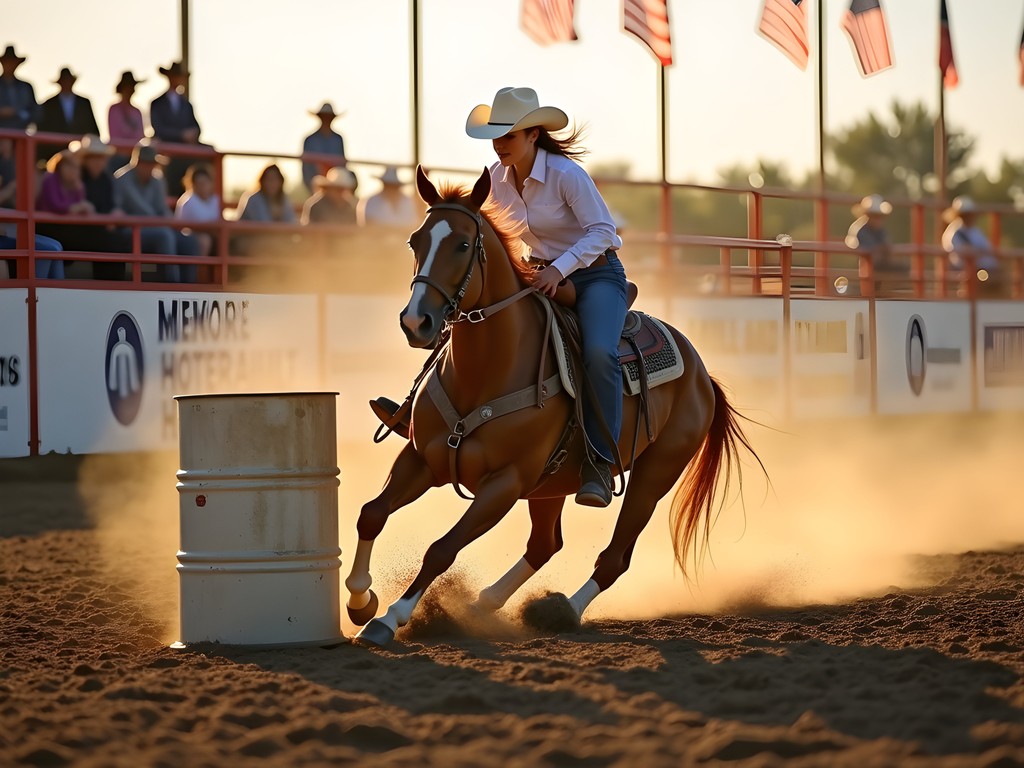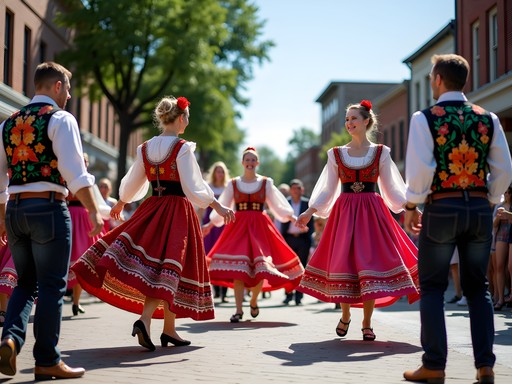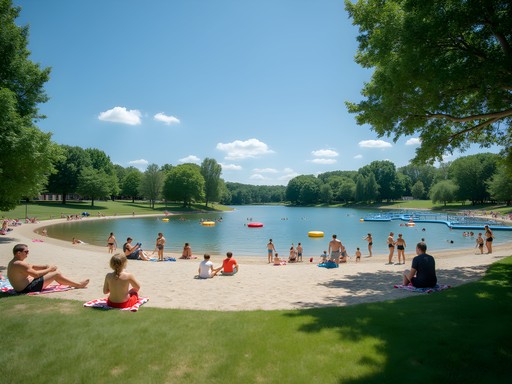Disclosure: This article contains affiliate links. We may earn a commission from purchases at no extra cost to you, which helps our travel content.
As someone who's tracked weather systems across Europe's most dramatic landscapes, I never expected to find such fascinating microclimates of culture in America's heartland. Yet Fremont, Nebraska—a modest town of roughly 26,000 inhabitants—presents a remarkably rich tapestry of cultural traditions that mirror the atmospheric diversity I study professionally. Nestled along the Platte River, this small Midwestern community has preserved heritage celebrations that offer families an authentic glimpse into America's immigrant history without the overwhelming crowds of larger destinations.
John C. Fremont Days: A Meteorologist's Paradise
Every July, as the warm continental air mass settles over the Great Plains, Fremont transforms for the annual John C. Fremont Days festival—a three-day celebration honoring the town's namesake explorer. As a meteorologist, I'm fascinated by how the weather patterns here create perfect conditions for outdoor festivities during this period, with typical daytime temperatures hovering around 29°C (84°F) with moderate humidity.
The festival grounds in John C. Fremont City Park become a living laboratory of historical reenactments, where families can witness demonstrations of 19th-century technologies that once seemed as revolutionary as our modern weather prediction models. My scientific curiosity was particularly captured by the blacksmithing demonstrations—watching the transformation of matter through precise application of heat and pressure mirrors many atmospheric processes I study professionally.
The children's activities zone offers young explorers hands-on historical experiences without the digital interfaces they're accustomed to—a refreshing analog experience in our increasingly virtual world. For optimal comfort during long festival days, I recommend bringing a cooling towel to manage the July heat while moving between outdoor activities.

💡 Pro Tips
- Arrive early (before 10 AM) on Saturday to secure parking near the main festival grounds
- The historical parade typically begins at 1 PM—position yourself along Main Street near 6th for the best viewing angles
- Many food vendors only accept cash, and ATM lines can grow lengthy by midday
Ethnic Festival: A Convergence of Cultural Fronts
Much like how weather fronts converge to create fascinating atmospheric phenomena, Fremont's annual Ethnic Festival in July represents a remarkable convergence of cultural traditions. This single-day celebration transforms downtown Fremont into a multicultural exhibition that would impress even my European colleagues.
The festival's geographical organization mimics what meteorologists might call 'cultural isobars'—distinct zones where Czech, German, Swedish, and Hispanic traditions maintain their unique characteristics while existing in close proximity. Each cultural zone features authentic cuisine, traditional music, and dance performances that have been preserved with remarkable fidelity despite generations of separation from their countries of origin.
During my visit, I was particularly struck by the Czech kolache pastries—their preparation methods have remained virtually unchanged for over a century, demonstrating the same kind of resilience to change that we observe in certain persistent weather patterns. The German area's polka bands created sound pressure waves that literally changed the atmospheric dynamics of the street, drawing crowds into spontaneous dance formations.
To document these ephemeral cultural displays properly, I relied on my audio recorder to capture the authentic sounds of each performance—something smartphone recordings simply can't match in terms of fidelity.

💡 Pro Tips
- Sample foods from at least three different cultural areas for a comparative experience
- The Swedish folk dancing typically occurs at 2 PM and 5 PM—schedule accordingly
- Bring small denominations of cash for food purchases to expedite transactions
Fremont's Railway Heritage: A Vintage Train Enthusiast's Delight
While not explicitly a festival, no visit to Fremont would be complete without exploring its railway heritage—a personal passion that intersects perfectly with my professional background. The Union Pacific Railroad played a crucial role in Fremont's development, creating both the economic and meteorological conditions that shaped the town's growth patterns.
The Fremont & Elkhorn Valley Railroad operates heritage train rides during summer weekends, offering a 14-mile journey aboard meticulously maintained vintage rolling stock. As someone who has documented Europe's historic railway systems extensively, I found the preservation efforts here impressively authentic. The mechanical precision of these restored trains parallels the exactitude required in meteorological instruments—both representing human attempts to harness natural forces through engineering.
For families, these train excursions provide an immersive educational experience that contextualizes Nebraska's development in a way static museums cannot. The gentle rocking motion of the carriages, combined with the rhythmic sounds of steel wheels on rails, creates a multisensory experience that children find mesmerizing.
Before your journey, I recommend picking up a railway guide from the gift shop to enhance your understanding of the technical and historical significance of what you're experiencing. For those serious about railway photography, a polarizing filter will help manage reflections when photographing these magnificent machines through the windows.

💡 Pro Tips
- Reserve heritage train tickets at least two weeks in advance during peak summer season
- Request seats on the west side of the train for afternoon departures to avoid direct sunlight
- The 1:30 PM departure offers optimal lighting conditions for photography
Days of '47 Rodeo: Cultural Meteorology in Action
Late July brings Fremont's Days of '47 Rodeo—an event that perfectly demonstrates what I call 'cultural meteorology': the predictable patterns of tradition that cycle through communities with the same reliability as seasonal weather systems. Having documented similar cultural phenomena across Europe, I find the American rodeo tradition particularly fascinating for its precise technical elements and community significance.
The rodeo grounds at Christensen Field transform into an arena where physics and human skill interact in ways that mirror atmospheric dynamics—riders and animals creating momentary systems of balanced and opposing forces. For families with children, this offers an unparalleled opportunity to observe practical applications of momentum, inertia, and centrifugal force in an exciting context.
What surprised me most was the rodeo's technical precision. Each event operates under strict parameters and timing requirements that would satisfy even the most demanding scientific protocols. The barrel racing competition particularly caught my attention—competitors navigate a cloverleaf pattern around barrels with millisecond precision, creating what amounts to a human-equine weather system moving through carefully calculated trajectories.
For families attending with younger children, I strongly recommend bringing hearing protection as the announcements and crowd reactions can reach sound pressure levels that may be uncomfortable for developing ears. Additionally, a stadium seat cushion will significantly enhance comfort during the 2+ hour performances on the aluminum bleachers.

💡 Pro Tips
- Arrive 45 minutes before the official start time to enjoy the pre-show activities and secure optimal seating
- The south-facing bleachers offer the best visibility while minimizing sun glare during evening performances
- Bring cash for the numerous food vendors and souvenir stands that don't accept cards
Weathering the Elements: Practical Considerations
As a meteorologist, I approach travel preparation with particular attention to environmental conditions. Fremont's summer climate presents specific challenges that families should prepare for to maximize enjoyment of its cultural offerings.
The region experiences what meteorologists call a 'humid continental climate' (Köppen classification: Dfa), characterized by hot summers with significant humidity. July temperatures typically range from 18°C (65°F) at night to 31°C (88°F) during peak afternoon hours, with relative humidity often exceeding 70%. These conditions create a heat index that can feel substantially warmer than the measured temperature.
My analysis of historical weather data for Fremont shows afternoon thunderstorms occur with approximately 30% frequency during summer months, typically developing between 2-6 PM due to daytime heating and atmospheric instability. These cells can form rapidly with minimal warning, making portable weather protection essential.
I recommend families carry a weather radio when attending outdoor festivals, as cellular service can become congested during large events, limiting access to weather apps. For sun protection that addresses both UVA and UVB radiation, a sun hat with proper ventilation is superior to baseball caps that leave ears and neck exposed to damaging ultraviolet radiation.

💡 Pro Tips
- Position yourself near identifiable landmarks at festivals to help family members regroup if separated during sudden weather events
- The public library offers excellent air-conditioned refuge during extreme heat periods between festival activities
- Morning events (before 11 AM) typically offer the most comfortable temperatures and lowest UV index readings
Final Thoughts
Fremont, Nebraska represents what I've come to recognize as a 'cultural microclimate'—a place where historical forces have created unique patterns of tradition that persist despite broader societal changes, much like how geographic features can create localized weather phenomena. For families seeking authentic American cultural experiences without the commercial overlay that often accompanies larger destinations, this small Midwestern town offers remarkable value and accessibility.
What makes Fremont's festivals particularly noteworthy is their organic authenticity—these are not performances staged primarily for tourists but genuine community celebrations that visitors are welcomed to join. The meteorological conditions of summer create an ideal environment for these outdoor heritage events, allowing multiple generations to connect with traditions that might otherwise be lost to time.
As both a scientist and cultural observer, I find places like Fremont invaluable for understanding the complex interactions between geography, climate, and human tradition. I encourage families to explore these smaller cultural centers—not just as alternatives to more famous destinations, but as worthy experiences in their own right. The cultural barometric readings here indicate something special worth preserving and experiencing firsthand.
✨ Key Takeaways
- Fremont's summer festivals offer authentic cultural immersion without commercial tourism trappings
- The town's diverse heritage celebrations reflect multiple European influences preserved in America's heartland
- Small-town festivals provide more opportunities for direct participation than larger tourist destinations
- Weather considerations significantly impact the festival experience and require specific preparation
- Family-friendly pricing makes Fremont an economical cultural education opportunity
📋 Practical Information
Best Time to Visit
July (when most major festivals occur)
Budget Estimate
$200-300 for a weekend family visit including accommodations
Recommended Duration
2-3 days (weekend)
Difficulty Level
Easy
















Comments
roamway
What's the best time of year to visit these festivals? I'm thinking of planning a heartland road trip next summer!
Sarah Powell
The John C. Fremont Days in July is definitely the highlight. It's hot but worth it - the historical reenactments are surprisingly detailed. I went last year and the weather patterns created this beautiful sunset backdrop for the evening concerts.
roamway
Thanks Sarah! July it is then. Do you think 2 days is enough to experience it?
Sarah Powell
Two days should be sufficient for the festival itself, but I'd add an extra day to explore the railway heritage sites Landon mentioned. They're less crowded and quite photogenic.
luckytime4821
As someone who grew up near Fremont, it's refreshing to see our local traditions through new eyes! The Railway Heritage event is even better than described - they sometimes let visitors operate the hand car on a short stretch of track. My kids went nuts for that last year. Landon, you really captured the essence of how these festivals connect to the town's history. One thing to add: if anyone visits during Ethnic Festival, don't miss the community potluck. Local families bring dishes from their heritage and the variety is incredible. It's like traveling around the world on one plate!
islandblogger
Those rodeo pics are amazing! Never been to Nebraska but this makes me wanna go!
cityzone
Those photos of the Days of '47 Rodeo are incredible! The sunset lighting is perfect.
wildbuddy6910
When exactly is the Days of '47 Rodeo? Thinking of planning a trip next summer!
luckytime4821
It's usually mid-July! Worth planning around for sure. I'd recommend bringing a good cooling towel because it gets HOT during rodeo season.
wildbuddy6910
Thanks for the tip! Will definitely look into July dates then.
Kimberly Murphy
Landon, I absolutely LOVE your meteorological approach to cultural analysis! I visited Fremont last summer during John C. Fremont Days and was blown away by how the whole town transforms. The historical reenactments were surprisingly authentic, and that heritage parade had me taking hundreds of photos! Did you get a chance to try the Czech kolaches at the Ethnic Festival? They reminded me of the pastries I had in Prague, but with a distinctly Nebraskan twist. Your 'cultural microclimate' concept is spot on - these small American towns often preserve traditions that have evolved in isolation, creating something truly unique.
luckytime4821
Those kolaches are AMAZING. My grandmother used to make them and the ones in Fremont are the closest I've found to her recipe.
Kimberly Murphy
@luckytime4821 Right?? I'm still dreaming about them! Do you know if any local bakeries sell them year-round or just during festivals?
journeyway7456
Never thought of Nebraska as a cultural hotspot! This definitely changes my perspective.
Bryce Diaz
Landon, your meteorological perspective on cultural festivals is refreshing! It reminds me of my own visit to Fremont three summers ago. I was driving solo across the Midwest when my car broke down just outside town. What could have been a disaster turned into one of the most memorable weekends of my journey. The local mechanic couldn't get the part until Monday, so I was "stuck" during the John C. Fremont Days. Ended up being adopted by a family who'd been attending for decades - they showed me all the insider spots, including a pie contest that wasn't even on the official program. The grandmother's rhubarb pie won third place, and I was their designated "good luck charm." These small town festivals reveal the authentic heart of America in ways big city events never can.
Landon Kelley
Bryce, that's exactly the kind of serendipitous experience I love about travel! Sometimes the unplanned detours become the highlight of the journey. And you're right - the pie contest is legendary but somewhat under-the-radar.
John Hart
Having analyzed cultural preservation patterns across 47 countries, I found Fremont's approach particularly noteworthy. The Railway Heritage Festival demonstrates a sophisticated balance between historical authenticity and accessibility. During my visit in 2024, I documented the meticulous restoration techniques used on the Union Pacific artifacts—truly impressive for a community of this size. For serious railway enthusiasts, I recommend bringing a field guide to fully appreciate the technical details of the locomotives. The volunteer docents possess extraordinary knowledge of regional railway development that rivals institutions in much larger metropolitan areas.
Bryce Diaz
Landon, your microclimate analogy is brilliant! I passed through Fremont three years ago during a cross-country solo trip and stumbled upon their Railway Heritage event completely by accident. What struck me was how the locals treated me like family within minutes of arrival. I ended up extending my stay by two days! If anyone's planning to visit, I recommend bringing a good travel journal to document the stories you'll hear from locals - they have incredible tales about the town's history that you won't find online. The volunteer at the Fremont History Museum spent two hours showing me personal photographs from festivals dating back to the 1950s. That's the kind of experience you can't plan for!
tripguy5091
That's exactly the kind of experience I'm hoping for! Did you stay in Fremont or commute from Omaha?
Bryce Diaz
I stayed at a small B&B in Fremont - can't remember the name but it was run by an older couple who served homemade bread every morning. Definitely stay in town if you can! The evening conversations on porches are where the real magic happens.
Venture X
Premium card with 2X miles, $300 travel credit, Priority Pass